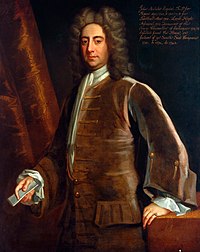John Aislabie
John Aislabie | |
|---|---|
 | |
| Chancellor of the Exchequer | |
| In office 20 March 1718 – 23 January 1721 | |
| Monarch | George I |
| Preceded by | The Viscount Stanhope |
| Succeeded by | Sir John Pratt (interim) |
| Personal details | |
| Born | 4 December 1670 |
| Died | 18 June 1742 (aged 71) |
| Nationality | British |
| Political party | Whig |
| Alma mater | St John's College, Cambridge Trinity Hall, Cambridge |
John Aislabie or Aslabie (English and British House of Commons from 1695 to 1721. He was of an independent mind, and did not stick regularly to the main parties. He was Chancellor of the Exchequer at the time of the South Sea Bubble and his involvement with the Company led to his resignation and disgrace.

Background and education
Aislabie's family were originally Yeoman farmers who lived in
St. John's College, Cambridge, in 1687 and at Trinity Hall, Cambridge, in 1692.[3] He inherited the Studley estate from his mother's family in 1693, and started serious development of the garden around 1716. He was the first in England to introduce natural landscaping and created the water garden at Studley Royal. His son, William Aislabie, added the ruins of Fountains Abbey to the estate.[4]
Political career
Aislabie was elected as a
Robert Harley he was appointed a Lord of the Admiralty from 1710 in the Tory administration. This proved a precarious appointment as Aislabie's Whig sympathies manifested in votes against the government.[1]
When the Whigs returned to office in 1714, Aislabie was made Treasurer of the Navy. He became an ally of the
Privy Council, and imprisoned in the Tower of London.[5]
Later life and contributions
After his release from prison, he retired to his estate and continued the development of the gardens.[4]
The
grade I listed.[7]
In 1723 Aislabie constructed
Waverley Abbey House on the site of former Cistercian Waverley Abbey in Surrey.[8]
John's son William Aislabie would also serve in Parliament for the Ripon constituency.[9]
References
- ^ a b "AISLABIE, John (1670-1742), of Studley Royal, nr. Ripon, Yorks. and Red Lion Square, London". History of Parliament Online (1690-1715). Retrieved 22 August 2018.
- doi:10.1093/ref:odnb/252. (Subscription or UK public library membershiprequired.)
- ^ "Aslabie, John (ASLY687J)". A Cambridge Alumni Database. University of Cambridge.
- ^ doi:10.1093/ref:odnb/252. (Subscription or UK public library membershiprequired.)
- ^ "AISLABIE, John (1670-1742), of Studley Royal, nr. Ripon, Yorks". History of Parliament Online (1715-1754). Retrieved 24 August 2018.
- S2CID 195038016.
- ^ Historic England. "Obelisk (Grade I) (1315492)". National Heritage List for England. Retrieved 9 January 2020.
- ^ "History". Waverley Abbey House. Archived from the original on 2 October 2013. Retrieved 1 September 2013.
- doi:10.1093/ref:odnb/96719. (Subscription or UK public library membershiprequired.)
Further reading
Wikisource has the text of the 1885–1900 Dictionary of National Biography's article about John Aislabie.
- Charles Mackay, Extraordinary Popular Delusions and the Madness of Crowds, available from Project Gutenberg

